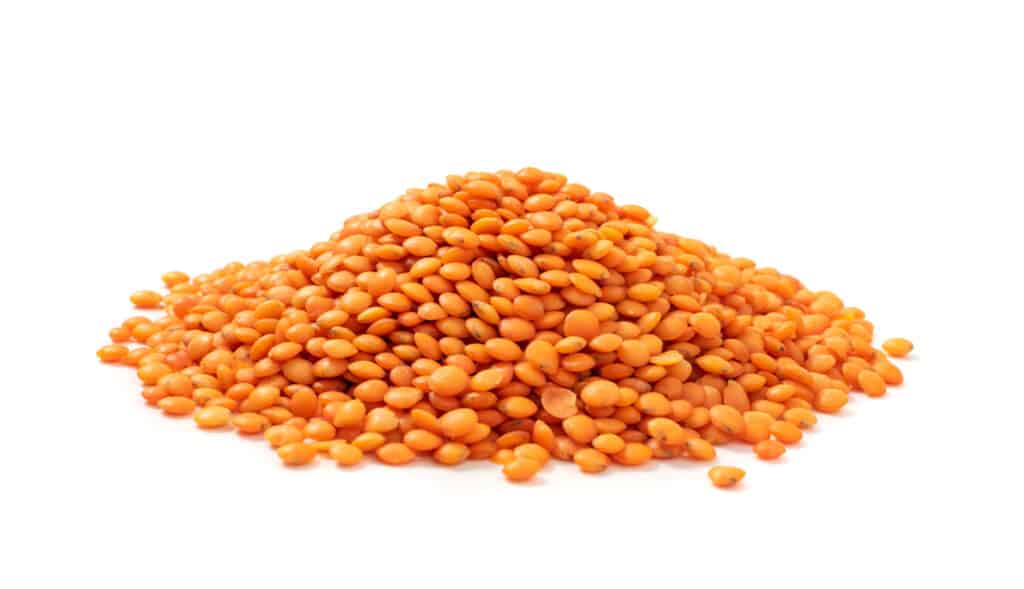Lentils and chickpeas are used by many of the same types of cuisines worldwide, from curries and stir-fries to hummus and falafel. They have similar growing requirements and are not fussy about conditions; they will improve the conditions by taking nitrogen from the air and fixing it into the soil. These two types of legumes grow in pods, with 2-3 seeds per pod, on a bush about two feet tall.
They are not identical, and there are several differences between the two. They have different growing requirements and different scientific names. The plants also look pretty different when growing. Let’s dive into a little bit more detail below.
Comparing Lentil vs. Chickpea

The lentil plant is a hairy plant with delicate tendrils and dainty leaves.
©Leo Pakhomov/Shutterstock.com
| Characteristic | Lentil | Chickpea |
|---|---|---|
| Scientific Family | Lens culiaris | Cicer arietinum |
| Macronutrients per 100g serving | 114 calories. 9g protein. 19.5g carbohydrate. 0.38g fat. 7.9g fiber | 164 calories. 8.86g protein. 27.4g carbohydrate. 2.59g fat. 7.6g fiber |
| Plant size | 16 inches tall | 20 inches tall |
| Pod size | 1.5 centimeters | 1 inch |
| Seed size | 4-6mm | 8-10mm |
| Plant description | Many hairy branches. Oblong leaves alternate down the branch. Flowers are white, pink, or blue. | Small feathery leaves that are opposite each other down the branch. White flowers. |
| Taste | Mild, earthy with slightly sweet undertones | Earthy with nutty undertones |
| Growing Requirements | Well-drained soil, plant seeds when the soil reaches 68°. Needs 8+ hours of sun per day. Tolerates hot weather. | Prefers poor soil. Plant seeds when the soil reaches 50°. Needs 3 months of cool weather to mature. |
| Uses | Soaked, germinated, fried, baked, boiled, turned into flour | Boiled, pureed, turned into flour. |
Key Differences Between Lentil and Chickpea
The key differences between lentils and chickpeas are their growing requirements, uses, and appearance.
As you can see, lentils and chickpeas share many characteristics but differ in several key areas. The chickpea seed and pod are larger than the lentil, and the chickpea has a much firmer texture. Some lentils are so small that they turn into a puree when cooked. The two plants also have opposite growing requirements; the chickpea likes it nice and cool while the lentil prefers hot sun.
Lentil vs. Chickpea: Growing Requirements

Chickpeas cannot handle waterlogged soil.
©Ahanov Michael/Shutterstock.com
To grow a chickpea plant, you start with sandy, nutrient-poor soil. If you have clay soil or rich compost, the chickpea plant will grow but never set seed, which is the part you are waiting to eat. Legumes are nitrogen fixers, so they don’t need any extra nitrogen in the form of fertilizer. Chickpeas are also cool-season annuals, so plant them outside simultaneously as your broccoli, cabbage, and peas. They prefer soil that is 50° to germinate and cannot tolerate a summer temperature higher than 85°. Another thing to consider is drainage; chickpeas cannot handle waterlogged soil, so keep this in mind when preparing your garden site.
To grow a lentil, you also need a well-drained site that doesn’t hold water. But it would be best if you had large quantities of the sun for this plant, eight hours minimum. The lentil is not a cool-season grower and prefers soil temperatures of 68° before it germinates. It thrives in USDA hardiness zones 5-11 with high summer temperatures well over 100 degrees. This legume is also a nitrogen fixer, so it will provide this nutrient for itself and does not need additional fertilizer.
Lentil vs. Chickpea: Uses

Some lentils are so small that they turn into a puree when cooked.
©Ermak Oksana/Shutterstock.com
Lentils are a staple food in many parts of the world. Lentil curry, stock, stuffing, and sweets are part of the daily diet in India, Fiji, Singapore, and the Caribbean. In Iran, rice and lentils are served with fried raisins. The Egyptians prepare a popular dish called kushari with lentils. In North and South America, soups and salads made with lentils are typical meals. In Ethiopia, a delicious stew called “kik wot” is the national food.
Chickpeas are popular in Mediterranean and middle eastern cuisines. They can be found in hummus and ground into flour to make falafel. In Indian cuisine, chickpeas are used in salad, soup, stew, and a lovely curry called chana masala. In Turkey, a dessert from sugared chickpeas, “noghl,” is a treat. In Italy, ciceri e tria is a famous pasta and chickpea dish.
Lentil vs. Chickpea: Appearance

Pile chickpeas close-up on a white background. Isolated
©innakreativ/Shutterstock.com
You can tell them apart if you put a lentil plant and a chickpea plant side by side. The lentil plant is a hairy plant with delicate tendrils and dainty leaves. It has tiny flowers that come in white, pink, or blue. When the plant is mature, pods that are only 4-6 cm long and contain two lentils per pod form.
The chickpea plant is larger in every way. It has feathery leaves that are larger and more robust than the lentil. The flowers come in white, sometimes with tiny blue or violet striations. The pods are 10mm long and contain 2-3 chickpeas per pod.
Up Next…
- Alligator vs. Crocodile vs. Caiman vs. Gharial: What are the Differences Between Crocodilians?
- Century Plant vs. Agave: Is There a Difference?
- Perennial vs Annual Plants
The photo featured at the top of this post is ©
Thank you for reading! Have some feedback for us? Contact the AZ Animals editorial team.






